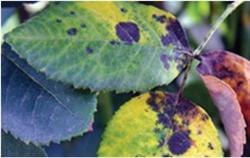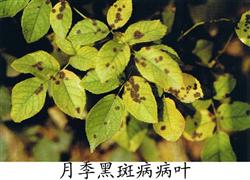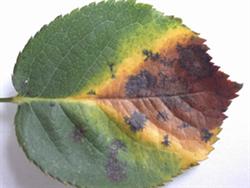Occurrence and control of black spot of rose

Rose and rose black spot disease is a worldwide disease, which is common in China, which is thought to damage leaves mainly, followed by petiole, leaf tip, young shoots and pedicels. The disease is more serious in the south and north, and the disease makes the leaves yellow and fall early. when the disease is serious in April and May and late August and September in summer, the leaves can all fall, which destroys the autumn flowering of rose and roses, and seriously weakens the tree. In addition to infecting rose and rose, the disease is also harmful to rose, golden cherry, Rosa roxburghii, Rosa roxburghii and so on. First, symptoms: after the leaf is infected, there are purple-brown round spots of different sizes, or irregular disease spots, with a diameter of about 4 mm to 12 mm, and the edges are ciliated, and then gradually develop into dark-brown disease spots, with yellow halos at the edges of the disease spots, radiating, and not very obvious at the initial stage; in the later stage, the edge of the spot is purple-brown or brown, and the radiation is clearly visible. In severe cases, the lower leaves are bare, the twigs are dry, and there are many small black dots on the disease spot, that is, the conidium disk of the pathogen. Second, the pathogen and occurrence regularity: the pathogen is Dysporium roseum, which is a subphylum of ascomycetes, and there are envelopes and ascospores on the ascospores. Overwintering on diseased remains with hyphae or conidia. Conidia are produced in the spring of the following year, which are damaged by wind, rain, dew, sprinkling or insect transmission. In Guangzhou, the disease completed its annual infection cycle asexually, and there was no obvious overwintering period. The disease occurred in the south of Guangzhou and the Pearl River Delta in mid-late April, the high temperature and humidity in summer were disadvantageous to the growth of rose and rose, the plant was in the "summer" stage, and the disease was relatively mild. Humidity has a greater impact on the disease than temperature, and the disease occurs early and seriously in years with early and more rainfall; the air humidity is high, rainy and dewy (fog) in the protected area is poorly ventilated, and it is easy to occur, and the bacteria can be infected repeatedly for many times, and the disease can occur throughout the growing season. especially in the plum rain season, typhoon rainstorm years, summer disease aggravation, aggravate the spread of disease. Rainy, foggy and dewy water occurred seriously, which occurred from April to May in Guangzhou, reached its peak in mid-May and mid-August, and decreased in September. The suitable temperature of the disease is about 20 to 25 ℃, the disease is more serious when the humidity is more than 90%, and it is disadvantageous to the occurrence of this disease when the humidity is above 30 ℃. The initial stage and the end stage of the disease vary according to the climate. In wet and rainy weather, leaf spores can germinate and invade in 6 hours, and the incubation period is 7 to 10 days. Especially in the field waterlogging, poor maintenance and management, the disease is more serious in the case of plant weakness, and there are great differences in disease resistance among varieties. However, the soil permeability is poor, and the disease is more serious in fields and gardens due to improper fertilizer and water management. Third, prevention and control measures: in summer, during the period of rapid growth of rose and rose, the incidence of infection is the highest, which is the period of high incidence of black spot and powdery mildew. 1. Select disease-resistant varieties. 2. Clear the pathogen. Persist in removing withered and diseased leaves every year to reduce infection of pathogens. 3. Enhance the resistance. Strengthen field management, rational fertilization, increase the application of phosphorus and potassium fertilizer, clear ditches and drain, no watering, moderate pruning, loosen soil and cultivate soil, improve root activity, improve growth, and enhance plant disease resistance. 4. Chemical control. At the beginning of the following spring, the crystal stone-sulfur mixture was sprayed 100 times before rose germination. When the new leaves unfold in summer, they begin to spray until winter. In the early stage of the disease, alternately spraying 3000-fold solution of black kill, 1000-fold solution of 75% chlorothalonil wettable powder, or 45% thiabendazole suspension, 40% flusilazole or 25% nitrazole EC, or 40% polysulfide suspension or 50% anthrax Fumei wettable powder or 50% compound thiophanate wettable powder, 70% methyl thiophanate 700-1000 times, 50% carbendazim 80-1000 times The spread of the disease can be controlled by spraying 1000 times of 80% Dysen zinc and 12.5% clear (spot removal) EC, spraying once every 7 days in the rainy season, spraying once in 7 to 10 days in the normal growing season and plum rain season, and spraying 4 to 5 times in a row. When the disease is serious, it can be sprayed 3000 times, 70%, 30% copper oxychloride suspension, 75% chlorothalonil, 12.5% EC 1000 times, 3 to 5 times in a row, once in 7 to 10 days. Among them, the control effect of black kill 3000 times liquid is the best.
- Prev

Preventive measures of Black spot of Rose
Rose black spot is a stubborn disease harmful to rose, which mainly occurs in leaves, twigs and pedicels. Most of the disease spots occur on the front of the leaves, and all the leaves from the lower to the middle of the seriously diseased plants will fall off, making the plant grow weakly, easily injuring the flower buds by low temperature, affecting flowering in the coming year, and even causing branches to die. The author.
- Next

Incidence and control measures of black spot of rose
Black spot of rose is a worldwide disease, which is widely distributed and occurs in all areas where rose is cultivated. In recent years, the disease is serious in many provinces and cities in China. The occurrence of black spot can cause the early defoliation of rose, affect the growth of rose and the survival rate of branch cutting, and reduce the ornamental and economic value. Black spot can also harm roses, roses, etc.
Related
- Fuxing push coffee new agricultural production and marketing class: lack of small-scale processing plants
- Jujube rice field leisure farm deep ploughing Yilan for five years to create a space for organic food and play
- Nongyu Farm-A trial of organic papaya for brave women with advanced technology
- Four points for attention in the prevention and control of diseases and insect pests of edible fungi
- How to add nutrient solution to Edible Fungi
- Is there any good way to control edible fungus mites?
- Open Inoculation Technology of Edible Fungi
- Is there any clever way to use fertilizer for edible fungus in winter?
- What agents are used to kill the pathogens of edible fungi in the mushroom shed?
- Rapid drying of Edible Fungi

